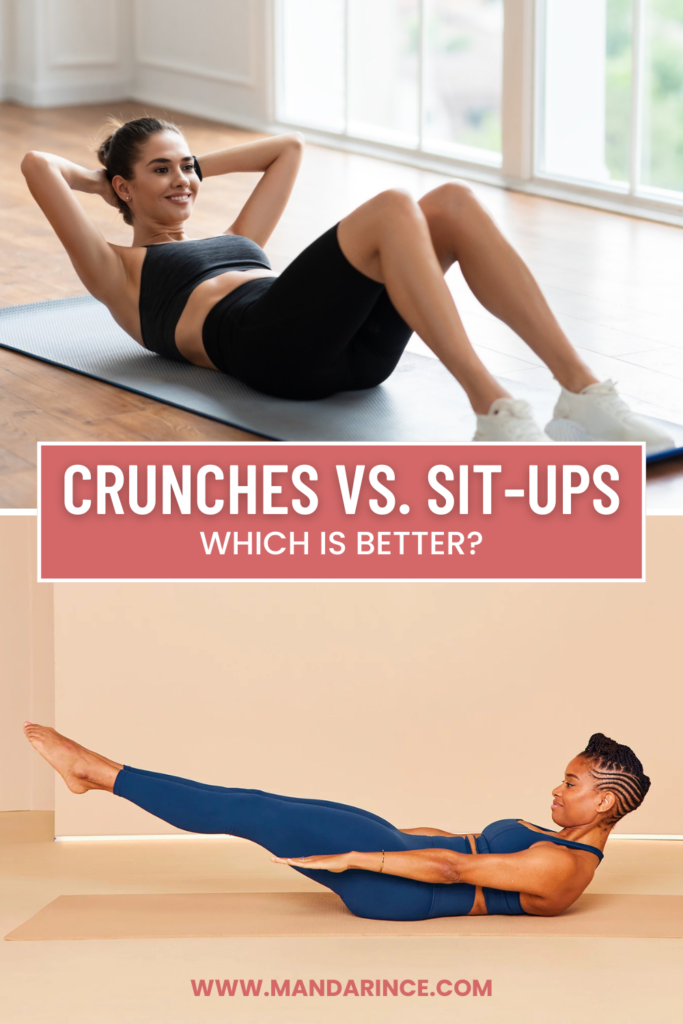When it comes to core-strengthening exercises, crunches and sit-ups are among the most popular choices. While both are often used interchangeably, they actually target different muscle groups and offer unique benefits. If you’re looking to build a strong, toned core, it’s essential to understand the differences between these exercises, their benefits, and which one aligns with your fitness goals.
In this guide, we’ll break down the key differences between crunches and sit-ups, their pros and cons, and help you determine which exercise is best for your workout routine.

What Are Sit-Ups?
Sit-ups are a full-body movement that strengthens the abdominal muscles, while also engaging the hip flexors, lower back, and chest. They involve a greater range of motion compared to crunches, making them a compound exercise.
How to Do Sit-Ups Correctly
- Lie flat on your back with your knees bent and feet flat on the floor.
- Place your hands behind your head or cross them over your chest.
- Engage your core and lift your torso towards your thighs.
- Lower your body back down to the starting position with control.
- Repeat for 10-15 reps.
Muscles Targeted
- Rectus abdominis (front abdominal muscles)
- Obliques (side abs)
- Hip flexors (connect thighs to lower back)
- Lower back & chest (secondary engagement)
What Are Crunches?
Crunches are an isolation exercise that primarily targets the rectus abdominis (your six-pack muscles). They involve a shorter range of motion than sit-ups, making them lower impact but highly effective for core activation.
How to Do Crunches Correctly
- Lie on your back with your knees bent and feet flat on the floor.
- Place your hands behind your head for support.
- Engage your core and lift your upper back off the ground.
- Hold for a second at the top, then slowly lower back down.
- Repeat for 15-20 reps.
Muscles Targeted
- Rectus abdominis (primary muscle worked)
- Obliques (minor engagement)
- Transverse abdominis (deep core muscles)
Pros and Cons of Sit-Ups & Crunches
Pros of Sit-Ups
- Engages multiple muscle groups – Works the abs, hip flexors, and lower back.
- Improves core strength and posture – A strong core enhances stability, balance, and mobility.
- Helps build endurance – Beneficial for athletes and those looking for functional strength.
- No equipment needed – Can be done anywhere.
Cons of Sit-Ups
- Higher risk of spinal strain – Incorrect form may cause back or neck pain.
- Overuse of hip flexors – Can lead to lower back discomfort if not done properly.
- Not ideal for beginners – Requires more control and flexibility.
Pros of Crunches
- Isolates abdominal muscles – Focuses on building a stronger core.
- Lower risk of spinal injury – Less movement reduces strain on the back.
- Easier for beginners – A great starting point for core workouts.
- Effective for muscle definition – Helps sculpt and tone the abs.
Cons of Crunches
- Limited muscle activation – Doesn’t engage the lower body.
- Less functional strength – Doesn’t contribute as much to overall movement efficiency.
- May not burn as many calories – Since it’s an isolation exercise, it’s not as effective for weight loss.
Crunches vs. Sit-Ups: Which One Is Better?
The better exercise depends on your fitness goals:
- Overall core strength & stability → Sit-ups
- Six-pack abs & definition → Crunches
- Beginners → Crunches (lower risk of injury)
- Full-body engagement → Sit-ups
If your goal is a stronger, more defined core, you may benefit from incorporating both exercises into your routine. Balance is key!
Crunch Variations to Try
Looking for variety? Try these crunch variations to target different muscle groups:
- Reverse Crunch – Focuses on the lower abs.
- Bicycle Crunch – Engages the obliques for a stronger core.
- Toe-Touch Crunch – Targets the upper and lower abs.
- Vertical Leg Crunch – Increases core engagement.
- Side Oblique Crunch – Helps define the waistline.
How to Incorporate Crunches & Sit-Ups into Your Routine
Beginner Routine:
- 3 sets of 10-15 sit-ups
- 3 sets of 15-20 crunches
- 30-second plank hold
Intermediate Routine:
- 3 sets of 20 sit-ups
- 3 sets of 20 crunches
- 40-second side plank hold
Advanced Routine:
- 4 sets of 25 sit-ups
- 4 sets of 25 bicycle crunches
- 1-minute plank hold
Both crunches and sit-ups have their place in a core-strengthening routine. While sit-ups engage more muscle groups, crunches isolate and define the abs with less strain on the back. The best approach? Incorporate both exercises, focusing on proper form to prevent injury and maximize results.
